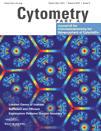
Experiment Overview
| Repository ID: | FR-FCM-ZYX4 | Experiment name: | MitoTracker dose response experiment | MIFlowCyt score: | 93.52% |
| Primary researcher: | Genevieve Clutton | PI/manager: | Genevieve Clutton | Uploaded by: | Genevieve Clutton |
| Experiment dates: | 2018-07-24 - 2018-07-25 | Dataset uploaded: | Aug 2018 | Last updated: | Aug 2018 |
| Keywords: | [T-cells] [mitochondria] [Immunologic techniques] | Manuscripts: | [30576071] |
|
|
| Organizations: |
University of North Carolina at Chapel Hill, Chapel Hill, (United States of America)
|
||||
| Purpose: | To assess the impact of varying doses of MitoTracker dyes on median fluorescence intensity (MFI) and the percentage of cells deemed 'MitoTracker high' based on fluorescence percentile gating. The latter approach involved removing outliers, identifying the fluorescence intensity of the brightest and dimmest events and then gating cells within the top 90% (above the 10th percentile) of this fluorescence range. Peripheral blood mononuclear cells (PBMC) were stained in triplicate with either 5 nM, 10 nM, 15 nM, 20 nM or 25 nM MitoTracker Deep Red, and either 25 nM, 35 nM, 50 nM, 75 nM, or 100 nM MitoTracker Green. | ||||
| Conclusion: | We demonstrate that while MitoTracker MFI increases with increasing dye concentration, the percentage of cells falling within the 10th percentile gate remains stable. | ||||
| Comments: | None | ||||
| Funding: | This study was supported by NIH NIAID grant U01 AI131310. Research reported in this publication was supported by the Center for AIDS Research award number 5P30AI050410. The content is solely the responsibility of the authors and does not necessarily represent the official views of the National Institutes of Health. The UNC Flow Cytometry Core Facility is supported in part by P30 CA016086 Cancer Center Core Support Grant to the UNC Lineberger Comprehensive Cancer Center. | ||||
| Quality control: | Measurements were performed in triplicate (three technical replicates per dye concentration). LSRFortessa performance was calibrated daily using CS&T Research Beads (BD Biosciences). Data were compensated using single-stained compensation controls. Fluorescence minus one controls were used to check for spectral overlap between fluorescence channels. | ||||
Experiment variables
| Doses | |
|---|---|
| · 100 nM MTG + 25 nM MTDR | 100 nM MTG + 25 nM MTDR_Tube_001_023.fcs · 100 nM MTG + 25 nM MTDR_Tube_002_024.fcs · 100 nM MTG + 25 nM MTDR_Tube_003_025.fcs |
| · 75 nM MTG + 20 nM MTDR | 75 nM MTG + 20 nM MTDR_Tube_001_020.fcs · 75 nM MTG + 20 nM MTDR_Tube_002_021.fcs · 75 nM MTG + 20 nM MTDR_Tube_003_022.fcs |
| · 50 nM MTG + 15 nM MTDR | 50 nM MTG + 15 nM MTDR_Tube_001_017.fcs · 50 nM MTG + 15 nM MTDR_Tube_002_018.fcs · 50 nM MTG + 15 nM MTDR_Tube_003_019.fcs |
| · 35 nM MTG + 10 nM MTDR | 35 nM MTG + 10 nM MTDR_Tube_001_014.fcs · 35 nM MTG + 10 nM MTDR_Tube_002_015.fcs · 35 nM MTG + 10 nM MTDR_Tube_003_016.fcs |
| · 25 nM MTG + 5 nM MTDR | 25 nM MTG + 5 nM MTDR_Tube_001_011.fcs · 25 nM MTG + 5 nM MTDR_Tube_002_012.fcs · 25 nM MTG + 5 nM MTDR_Tube_003_013.fcs |
